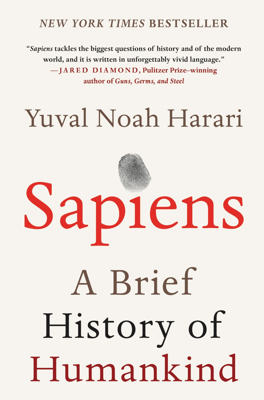An Animal of No Significance
Overview
"Sapiens: A Brief History of Humankind" by Yuval Noah Harari traces the history of the Homo sapiens species, beginning from the origin of the universe, through significant evolutionary stages, to the dominance of Homo sapiens as the solitary human species. Harari outlines major revolutions: the Cognitive, Agricultural, and Scientific, examining their impacts on both humans and the environment.
Early Human Context
Homo sapiens emerged about 2.5 million years ago, evolving from the Australopithecus. Despite developing larger brains and advanced tools, early Homo sapiens were not significantly distinct from other animals in their environment, such as chimpanzees or elephants, in terms of impact or behavior.
The Evolutionary Timeline and Taxonomy
- Physics narrates the tale of the universe starting with the Big Bang about 13.5 billion years ago.
- Chemistry follows with the formation of atoms and molecules several hundred thousand years post-Big Bang.
- On planet Earth, about 3.8 billion years ago, biology takes over with molecules forming complex organisms.
- About 70,000 years ago, the history of human cultures began.
Humans are classified into species based on reproductive compatibility. The genus Homo includes several human species, but Homo sapiens (wise man) are today's survivors after others like Homo neanderthalensis and Homo erectus went extinct.
Broadening the Human Species
Human species not only included Homo sapiens but also others like Homo neanderthalensis (Neanderthals) and Homo erectus. These species cohabited the Earth, with diverse adaptations to different environments, from forests to ice-covered regions. Contrary to a linear evolutionary model, the archaeological record shows that multiple human species existed concurrently, sharing the planet.
Unique Traits and Survival Strategies
Humans have notably large brains relative to body size, consume a significant amount of energy for brain function, and have a unique upright posture, which has influenced our development and survival strategies. Though advantageous, such traits presented challenges such as difficult childbirths and dietary limitations which were mitigated by the development of cooking and tool use.
Inter-Species Interactions and Extinctions
Homo sapiens eventually spread out of Africa about 70,000 years ago, encountering and oftentimes replacing other human species. This spread may have involved both interbreeding and conflict, leading to the extinction of other species. The interactions between different human species were complex, involving genetics, competition, and possibly conflict or violence.
Conclusion
The dominance of Homo sapiens can largely be attributed to sophisticated language capabilities, allowing for better coordination, planning, and survival strategies, ultimately enabling humans to outlive and outperform other species, leading to their current status as the sole survivors of the genus Homo. This chapter sets the stage for understanding how Homo sapiens came to dominate the globe through both cooperation and conflict.
